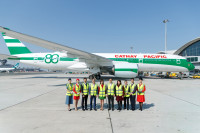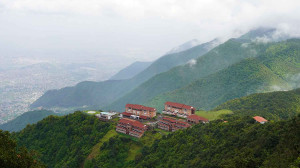Money
Nepal wants to be an agriculture-driven economy but future of the sector is in crisis
Share of agriculture in the country’s economy has been plummeting. Although 60 percent of Nepalis still depend on agriculture, it accounts for just 25 percent of the GDP.
Sangam Prasain
Tuesday is Asar 15. It is celebrated as National Paddy Day and is a photo opportunity for the agriculture minister to soil his hands and plant some paddy saplings.
In the national imagination and the government’s wishful thinking, Nepal’s agricultural sector is the basis of its economy.
But figures tell a different story.
Agriculture made up 66.9 percent of the gross domestic product (GDP), in 1970. But since then its share has been gradually decreasing and was a mere 25 percent in 2018, according to an analytical report published by the Central Bureau of Statistics recently.
“This means, the agriculture sector has not performed well and other sectors like tourism and manufacturing have taken over it,” said Hem Raj Regmi, deputy director general at the bureau, the central agency for the collection, consolidation, processing, analysis, publication and dissemination of statistics in Nepal. “Clearly, we can now say Nepal has shifted from an agriculture-driven economy to remittance-driven economy.”
But, while agriculture has a multiplier effect in the economy in the creation of jobs and supporting other sectors, remittance doesn’t directly contribute to the economy despite the huge amount of money it generates for the economic activities, particularly consumption, in Nepal, according to economists.
“Obviously, this is a cause for alarm,” Regmi told the Post.
According to the World Bank’s Migration and Development Brief, remittances to Nepal stood at $8.1 billion in 2020, a fall of about 2 percent compared to the previous year largely due to the pandemic as international flights were suspended for months.
The report said the contribution of remittances to the economy is equivalent to 23.5 percent of the GDP.
On the other hand, agriculture has been regarded as the mainstay of economic prosperity for its contribution to the GDP and livelihood of the population, according to the 15th Five-year Plan from fiscal year 2019-20 to fiscal year 2023-24.
The 15th Plan targets to transform the agriculture sector into a competitive, climate-resilient and export-oriented industry.
“But that’s only on paper,” said Yam Kanta Gaihre, a soil scientist. “The agriculture programmes and policies of Nepal are so good but they cannot get implemented.”
Economists say low returns from agriculture is the key reason behind its falling allure among Nepali youths.
Internal factors affecting Nepal’s agriculture sector growth are insufficient public investment, inadequate irrigation infrastructure, poor agriculture-related marketing policies, and climate vulnerabilities.
Then there are external factors. These include excessive economic liberalisation and zero tariffs on agricultural products.
“It’s easy to buy and eat rather than grow and eat,” said Gaihre, “Because the production cost is so high.”
Nepal has brought various plans and policies to increase agricultural production and productivity but this never materialised. With agricultural productivity remaining stagnant, millions of youths have no option but to travel abroad in search of jobs.
Economists put forth several reasons for why agriculture is no longer the engine of economic growth.
The economic liberalisation of the 1990s and greater openness to trade has led to a reduction in the economic potential of the rural sector and cheap imported goods, including agricultural produce, has displaced the locally-produced goods, said economist Keshav Acharya.
“With rapid global technical change and increasingly integrated markets, prices fell faster than the increase in yields in Nepal,” he said.
In Nepal’s case, it was thought that there would be an agricultural revolution resulting in increased production which in turn would support industry and manufacturing.
“While many countries in Asia had followed the path, in Nepal, despite economic graduation, there was a jump to the service sector,” said Acharya. “There was no development in manufacturing and industry. This is a sign of unsustainable economic transformation.”
The manufacturing sector as a proportion of the economy has in fact declined as in 2000 its contribution to the GDP was 10 percent but has now dropped to less than 6 percent, according to him.
After economic liberalization, the integration of rural with urban areas began and young people started moving out of agriculture and headed to towns and then abroad.
The latest development of this trend, according to Acharya, was the rapid development of the road network across the country.
“The value of land, due to the massive road building, has gone up so high that there is no value in cultivating in the same land,” said Acharya. “It’s a trading asset both in urban and rural areas.”
He said that a bigha (0.67 hectare) of land costs Rs10 million in rural areas with road connectivity but if it is sold and the money is deposited in a bank under a fixed deposit scheme, the annual earning is three times higher than what a farmer's income would be.
“And it’s easier to buy goods with that income than farm,” said Acharya.
But according to Gaihre, although farmers' income sources may have diversified and they are able to buy and eat, the country has lost a mode of production.
“Farming holds no charm anymore,” he said.
An effect of the lower income from farming due to the low production is that Nepal's agricultural goods import bill continues to expand, ballooning to an all-time high of over Rs250 billion in the fiscal year 2019-20.
The country’s import-promoting policies, high production costs and change in consumer behaviour are also reasons for this.
The agricultural goods imports bill in 2009-10 was just Rs44.43 billion. In 10 years, it has grown by almost six times.
While the country’s overall imports dropped by 15.63 percent to Rs1.19 trillion in the last fiscal year, ending mid-July, due to Covid-19 pandemic-related restrictions, agricultural goods imports continued to increase. The share of agro products in the total import bill has swelled to 21 percent.
It is not that there is no market for agricultural produce as evident from Nepal's soybean oil exports to India which hit a staggering Rs42.34 billion in the first 11 months of the current fiscal year, a four-fold jump from Rs10.12 billion in the same period in the previous fiscal year, making it the country's number one export commodity. It exported 246,376 tonnes of processed soybean oil in the same period.
Nepal produces very little soybean oil of its own, in fact, just 31,567 tonnes of raw soybean annually, which is not enough to meet the requirement of even a fraction of its own population.
This is possible because Nepal traders import soybean oil exploiting loopholes in the zero-tariff privilege given to Nepal as a least developed country and then export it to India.
Despite such potential, the government has never encouraged farmers to produce soybean but instead encourages traders to import and export the produce to generate revenue, according to economists.
But as the GDP rises and the share of agriculture typically decreases, the question is how important these multiplier effects are, especially when significant levels of poverty remain in the agriculture sector which still employs over 60 percent of the population, Acharya said.
“Even as the demand for agricultural produce increases its importance is declining in the overall economy,” said Regmi of the government’s Central Bureau of Statistics.




 5.44°C Kathmandu
5.44°C Kathmandu















